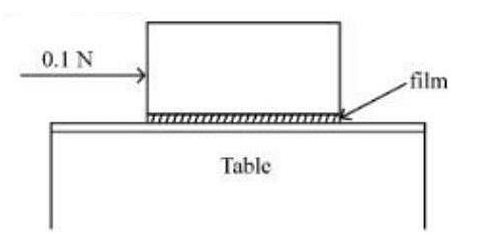Question:
A lead shot of $1 \,mm$ diameter falls through a long column of glycerine. The variation of the velocity with distance covered (s) is correctly represented by
A lead shot of $1 \,mm$ diameter falls through a long column of glycerine. The variation of the velocity with distance covered (s) is correctly represented by
Updated On: Apr 26, 2024
Hide Solution
Verified By Collegedunia
The Correct Option is A
Solution and Explanation
In the beginning due to gravity pull, the lead shot will be accelerated and hence will move, with increasing velocity for some time When the viscous force balance the gravity pull, then the shot will move with constant velocity. As in the beginning, the velocity of shot is not fully linear with the effective distance covered by the shot.
Was this answer helpful?
0
0
Top Questions on Viscosity
- A metal block of base area \(0.20 \,m^2\) is placed on a table, as shown in figure. A liquid film of thickness \(0.25\, mm\) is inserted between the block and the table. The block is pushed by a horizontal force of 0.1 N and moves with a constant speed. If the viscosity of the liquid is \(5.0×10^{−3}Pl\), the speed of block is ________ \(×10^{−3}m/s\)

- JEE Main - 2023
- Physics
- Viscosity
- An air bubble of diameter 6 mm rises steadily through a solution of density 1750kg / m3 at the rate of 0.35 cm/s. The co-efficient of viscosity of the solution (neglect density of air) is ____Pas (given, g = 10ms-2)
- JEE Main - 2023
- Physics
- Viscosity
- The sensitiveness of a bubble tube in a level would decrease if.
- Given below are two statements: one is labelled as Assertion A and the other is labelled as Reason R.
Assertion A: As temperature increases, viscosity of air decreases.
Reason R: As the temperature increases, activity of air molecule increases.
In the light of the above statements, choose the correct answer from the options given below - Unit of kinematic viscosity is.
View More Questions
Questions Asked in VITEEE exam
- Two identical blocks A and B, each of mass 'm' resting on a smooth floor are connected by a light spring of natural length L and spring constant K, with the spring at its natural length. A third identical block 'C' (mass m) moving with a speed v along the line joining A and B collides with A. the maximum compression in the spring is
- VITEEE - 2023
- work, energy and power
- Assertion :
The binding energy of the nucleus increases with the increase in atomic number.
Reason :
Heavier elements have a greater number of non-radioactive isotopes than radioactive isotopes. - The half-life of radioactive radon is 3.8 days. The time at the end of which \(\frac{1}{20}th\) of the Radon sample will remain undecayed is (given log10e=0.4343)
- Which element has more electron gain enthalpy among chalcogen group?
- VITEEE - 2022
- sulphur
- Coin is tossed till heads is obtained what is expectation of no. of coin tosses
- VITEEE - 2022
- Random Variables
View More Questions
Concepts Used:
Viscosity
Viscosity is a measure of a fluid’s resistance to flow. The SI unit of viscosity is poiseiulle (PI). Its other units are newton-second per square metre (N s m-2) or pascal-second (Pa s.) The dimensional formula of viscosity is [ML-1T-1].
Viscosity: Formula
Viscosity is measured in terms of a ratio of shearing stress to the velocity gradient in a fluid. If a sphere is dropped into a fluid, the viscosity can be determined using the following formula:
η = [2ga2(Δρ)] / 9v
Where ∆ρ is the density difference between fluid and sphere tested, a is the radius of the sphere, g is the acceleration due to gravity and v is the velocity of the sphere.
Viscosity: Types
- Dynamic viscosity: When the viscosity is measured directly by measuring force. It is defined as the ratio of shear stress to the shear strain of the motion. Dynamic viscosity is used to calculate the rate of flow in liquid.
- Kinematic viscosity: There is no force involved. It can be referred to as the ratio between the dynamic viscosity and density of the fluid. It can be computed by dividing the dynamic viscosity of the fluid with fluid mass density.
- Laminar flow: Laminar flow is the type of flow in which the fluid moves smoothly or in a regular path from one layer to the next. Laminar flow occurs in lower velocities.







